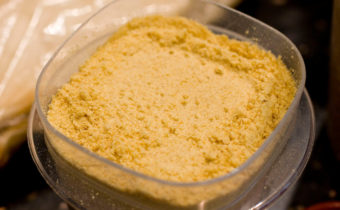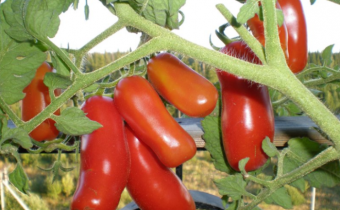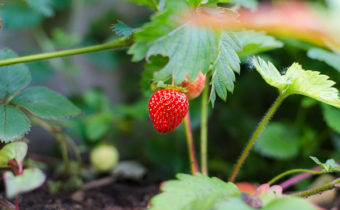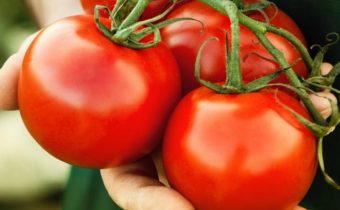How to deal with blight on tomatoes in the greenhouse folk remedies and fungicides
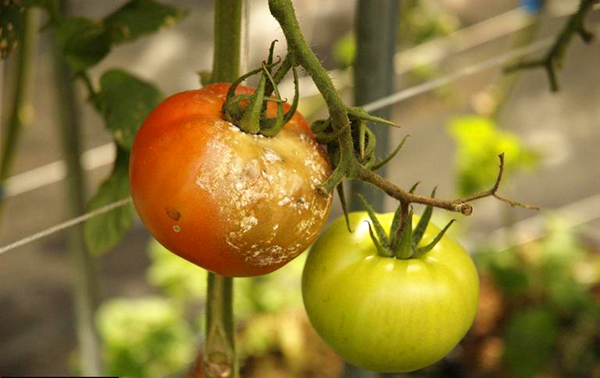
Of all the known diseases of tomatoes most often have to deal with blight. The disease spreads quickly and affects both the stem and the fruit, so treatment measures need to be taken immediately, otherwise the entire crop will be destroyed. There are many drugs and folk remedies for protection against the disease. They will help save the culture and neutralize the dangerous fungus.
Causes and conditions of phytophthora
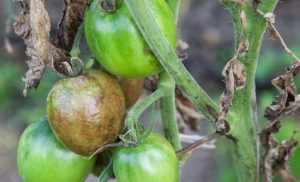 Phytophthora – fungal diseaseits reproduction occurs by spores. Spores winter well in the soil, and can also affect other vegetable crops: potatoes, cucumbers, peppers, eggplants. With the onset of spring, fungal spores are activated and infect a vegetable. The first signs of infection are as follows:
Phytophthora – fungal diseaseits reproduction occurs by spores. Spores winter well in the soil, and can also affect other vegetable crops: potatoes, cucumbers, peppers, eggplants. With the onset of spring, fungal spores are activated and infect a vegetable. The first signs of infection are as follows:
- the appearance of dark brown spots. They quickly spread along the stem and leaves;
- the formation of fluffy plaque white on the back of the sheet;
- the appearance of dark spots on the fruits of a vague shape.
The disease spreads mainly along the lower part of the plant and gradually passes to the upper shoots and the tomatoes themselves. Even if the fruits were torn healthy, but with a sore bush, then over time brown spots will appear on the skin of the tomato. After a couple of days, the tomato will be completely spoiled and not suitable for consumption.
Late blight manifests itself in the second half of summer, when the ambient temperature subsides a bit and the weather becomes more rainy. In conditions of high humidity spores grow and attack tomatoes. The appearance of fogs, cold nights - the most favorable conditions for the development of the disease.
If the temperature of the day warms up above 25 degrees, and the weather is sunny, the phytophthora perishes.
Sometimes gardeners themselves create the prerequisites for the development of the disease. The reasons for its appearance are:
- excess nitrogen in the soil;
- earth deficiency of trace elements (potassium, magnesium, manganese, copper);
- bushes planted too close to each other;
- before planting the land was not treated with potassium permanganate.
Methods of struggle
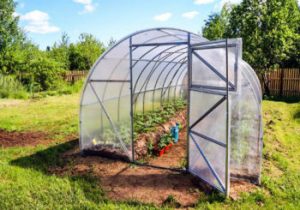 As soon as signs of infection were found, proceed to save tomatoes. The struggle is aimed at the destruction of already arisen dispute. Fungicides have a detrimental effect on the fungus - fast-acting drugs that block the activity of spores and lead to its death. The use of folk remedies also gives a positive result, helps get rid of the fungal plague and protect the crop.
As soon as signs of infection were found, proceed to save tomatoes. The struggle is aimed at the destruction of already arisen dispute. Fungicides have a detrimental effect on the fungus - fast-acting drugs that block the activity of spores and lead to its death. The use of folk remedies also gives a positive result, helps get rid of the fungal plague and protect the crop.
Before using any means, always consider that there are biological and safe preparations for your health, and there are chemicals. They accumulate in the fruit and can lead to poisoning.
Fungicide use
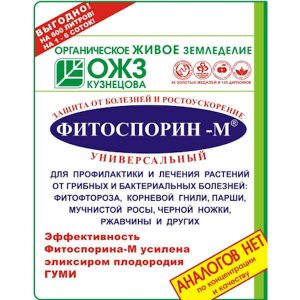 Fitosporin and Ekosil are considered the most common and well-known drugs. 5 grams of Fitosporin dissolved in 10 liters of water and irrigated with a solution of tomato bushes. Ecosil is available in liquid form. Dilute 15 drops of the drug in 3 liters of water and spray the tomatoes. From the fungus help other, equally effective means - Bordeaux mixture, Tattoo, MC.
Fitosporin and Ekosil are considered the most common and well-known drugs. 5 grams of Fitosporin dissolved in 10 liters of water and irrigated with a solution of tomato bushes. Ecosil is available in liquid form. Dilute 15 drops of the drug in 3 liters of water and spray the tomatoes. From the fungus help other, equally effective means - Bordeaux mixture, Tattoo, MC.
The drug Kvadris gives instant results. The main active component in the composition is azaxistrobin. This is a new substance with a wide spectrum of action.Getting on the leaf, Quadrice immediately suppresses the pathogen and eradicates it from the plant. The additive does not adversely affect the fruits themselves and is considered safe for the human body.
Important!
When using fungicides, you must use personal protective equipment - gloves and goggles. If it comes into contact with the skin or mucous membrane, the active ingredients may cause an allergic reaction.
Many gardeners who have previously experienced a fungal disease speak positively of Ridomil Gold. The drug acts not only on the surface of the leaf, but also penetrates through the pores inside and kills the infection. As a result, tomatoes are protected both from the outside and inside. After using the drug, phytophthora dies immediately and does not return.
Regardless of the remedy chosen, the treatment is as follows:
- Upon detection of infected shoots, they are immediately cut to a healthy place and burned.
- Dilute any fungicide with water and irrigate the remaining shoots and leaves.
- The earth is watered with a weak solution of potassium permanganate or a fungicide, and then loosened well.
- After a week, the treatment is repeated.
When the tomato growing season is over, the whole soil, where the infected culture has grown, is carefully dug up and shed with a solution of Fitosporin or Trichodermin. These additives prevent the occurrence of phytophthora.
Folk ways
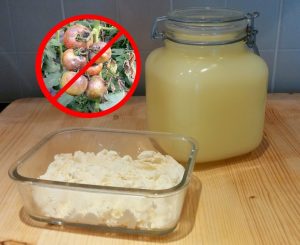 Folk remedies are very fond of gardeners for their safety in use. In action, they are considered to be no less effective than some fungicides. The best cure for fungi is iodine. 10 milliliters of alcohol iodine and diluted in 10 liters of water. Sprays and stems of the plant are sprayed with the solution. After 2-3 days, the treatment is repeated.
Folk remedies are very fond of gardeners for their safety in use. In action, they are considered to be no less effective than some fungicides. The best cure for fungi is iodine. 10 milliliters of alcohol iodine and diluted in 10 liters of water. Sprays and stems of the plant are sprayed with the solution. After 2-3 days, the treatment is repeated.
Garlic kills pathogens and prevents its development. To prepare the product, 200 grams of peeled garlic are minced in a meat grinder, poured with a bucket of water and infused for 2-3 days. Apply garlic infusion on the shoots and plant stem every 2 weeks. Sometimes garlic is replaced by onions.
Lactic acid bacteria block the reproduction of fungal spores and prevent it from developing. You can use regular milk or kefir. 100 milliliters of the product is diluted with water in a ratio of 1:10 and tomatoes are sprayed. Such an additive is used not only during the treatment of the disease, but also as a preventive measure.
Attention!
Before any treatment, the infected shoots are first removed. They can not be treated, but can infect a healthy part of the plant.
For treatment for the first time suitable solution of copper sulfate. Copper leads to the death of the dispute, and the tomatoes recover. On a bucket of water you need to take 10 grams of copper sulfate and 100 grams of soap, crushed on a grater. Put the mixture on the bushes 1 time in 7-10 days until the late blight.
Greenhouse Prevention
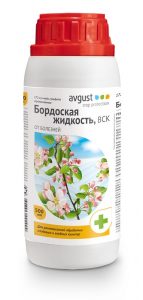 To avoid having to deal with a dangerous disease, you need to carry out prevention in a timely manner. Since most often the infection occurs from the ground, the soil is dug up in the fall and spring. Before planting, tomatoes are treated with a weak solution of potassium permanganate, a little ash is added to the ground. The distance between adjacent tomato bushes should not be less than half a meter.
To avoid having to deal with a dangerous disease, you need to carry out prevention in a timely manner. Since most often the infection occurs from the ground, the soil is dug up in the fall and spring. Before planting, tomatoes are treated with a weak solution of potassium permanganate, a little ash is added to the ground. The distance between adjacent tomato bushes should not be less than half a meter.
After transplantation, after 2-3 weeks, tomatoes are sprayed with a 2% solution of Bordeaux mixture or 2% solution of blue vitriol. Saline solution can be irrigated (200 grams of salt per 10 liters of water). Treatment from phytophthora is repeated after 2 weeks, and then in the middle of July. Do not forget when growing tomatoes to make in the soil mineral and organic fertilizers. They enhance the protective function of plants and stimulate the formation of healthy shoots.
Watering tomatoes no more than 1 time in 7 days, during dry time, watering can be increased, but under the condition that the earth will completely dry out. In order to not increase the humidity in the air, a thin layer of peach mulch in the form of peat is placed on a moistened soil.Peat takes away extra moisture, but at the same time retains water in the ground for the root system. Watering seedlings can only be in the morning, before noon. Watering in the evening is fraught with the fact that water from the leaves does not have time to be absorbed and remains on the surface, thereby creating a favorable environment for the development of fungus. After watering in the greenhouse, the doors and windows open, normalize air circulation.
Varieties resistant to infection
 It is believed that if you plant tomatoes with late blight resistance, they will not be infected. In fact, it is not. Absolutely all varieties of tomatoes are able to become the object of attack of the fungus. Resistance from tomatoes is possible, but it does not last long and ends with a complete defeat of the culture. To varieties of tomatoes that are not immediately infected with late blight, include Kostroma, Blizzard, Raisa, Parter, Dragonfly.
It is believed that if you plant tomatoes with late blight resistance, they will not be infected. In fact, it is not. Absolutely all varieties of tomatoes are able to become the object of attack of the fungus. Resistance from tomatoes is possible, but it does not last long and ends with a complete defeat of the culture. To varieties of tomatoes that are not immediately infected with late blight, include Kostroma, Blizzard, Raisa, Parter, Dragonfly.
Since the main development of the disease occurs in the second half of the summer, it is necessary to choose varieties with an early ripening period. These are considered SankaAlpha Explosion, Parodist, Amur Stand.
If the infection of the fruit still happened, it does not matter: they can still be saved. The fungus is afraid of high temperature, so if the diseased tomatoes are treated in hot water, they will be suitable for consumption. This method is suitable only for those fruits on the surface of which there are no black spots. It is possible that such tomatoes were plucked from an infected shoot, but the fungus is already in the pulp. Water is poured into the pot at a temperature of 60-65 degrees and tomatoes are soaked in it for 30 minutes. You can repeat the procedure several times, the main condition - to monitor the skin, at high temperatures, it can crack.
Seeds from diseased fruits are treated in the same way - they are calcined several times in the oven at a temperature of 60-70 degrees. Before planting, seeds are soaked in a weak solution of potassium permanganate.
Late blight is recognized as a serious disease, but it is easily curable with timely and effective control of it. When growing tomato culture, it is necessary to observe the frequency of watering, cut off the stepchildren, feed them and prevent diseases. If all of the above items are met, late blight will never attack tomatoes, and the harvest will be tasty and healthy.


